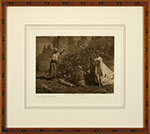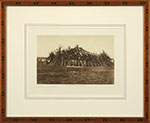
- ESTABLISHED 1976 -
Curtis
Edward S.
(1868 - 1952)
Edward S. Curtis is the most-recognized photographer of Native Americans because of his colossal work, The North American Indian (1907-1930). It consists of twenty portfolios of large-size photogravures and twenty volumes of text with examination into eighty Indian groups. The photographer’s belief, shared with others of his generation, was that the North American Indian was a vanishing race and Curtis became all consumed in documenting their culture.
Curtis had a strong artistic impulse, which led him to use his camera to produce images as beautifully composed works of art. The photographers artistic needs, at times, skewed fact. Nonetheless, Curtis produced a substantial body of work on the North American Indians; tens of thousands of images, some 2,200 of which appear as lavishly produced photogravure sets. The body of work is such that the sheer numbers of photographs serves invaluable in both ethnographic and historical purpose, though sometimes slanted.
Curtis was born in 1869 in the state of Wisconsin. He grew up in an area where Indians we still very much seen. As a young man, Curtis has an epigrammatic education of six years, but was already experimenting with a homemade camera as a youth. He acquired this knowledge from the popular textbook “Wilson’s Photographics.” After his father’s death, Curtis became a photographer and moved to Seattle in 1891. He first worked in a photographic store, which he later took over.
In the mid 1890s, Curtis began photographing local Puget Sound Native Americans. One of his earliest models was Princess Angeline, the aged daughter of Sealth, the Suquamish chief after whom Seattle was named. Later, as an official photographer of the 1899 Harriman Expedition, Curtis documented the Alaskan wilderness. This was a pivotal experience for Curtis and greatly increased his interest in Native cultures. He visited tribal communities in Montana and Arizona and began in earnest to photograph many other Native Americans in the West, spending more time in the field and less time in his studio. The idea of creating an expansive documentary of the Indian tribes that were dying out most likely came to him in 1903 or 1904.
Curtis’ North American Indian project by in large was funded by industrialist and banker J.P. Morgan, who was impressed by his “attempt at the impossible.” The project was to be turned into a twenty “volume” and twenty “portfolio” set of handmade books comprised of nearly 4000 pages of text and 2,2000 photogravures. Curtis’s undertaking cost him considerable financial and emotional difficulty. Estimated by the photographer to take only five years, it took him the better part of thirty. The project caused his divorce and he suffered a nervous breakdown upon its completion in 1930.
When he died in 1952, little known and penniless, his lifework with Native Americans had all but faded into anonymity. Edward S. Curtis's work is today recognized as one of the most significant records of Native culture ever produced. A public anthology of his work, the Edward S. Curtis Collection, can be found in the U.S. Library of Congress.





